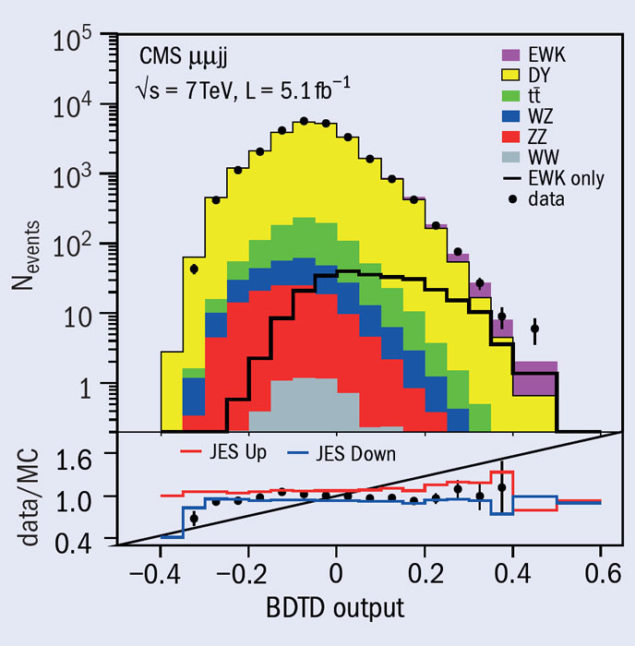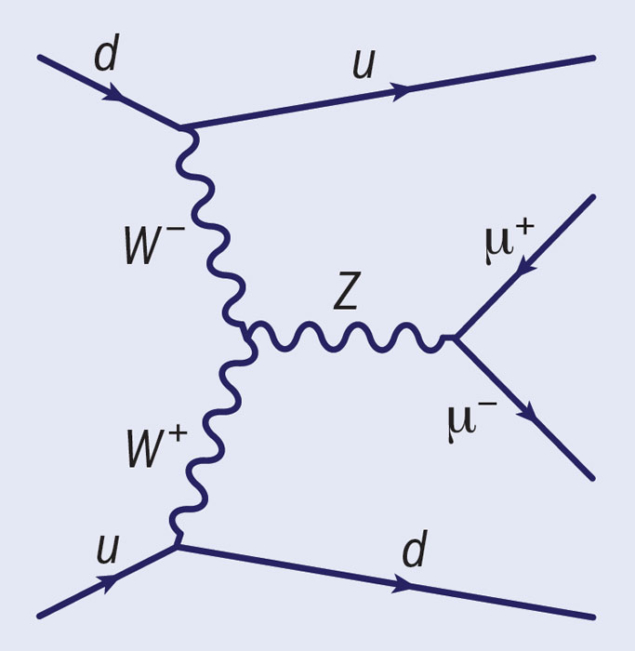In proton collisions at the LHC, vector boson fusion (VBF) happens when quarks from each one of the two colliding protons radiate W or Z bosons that subsequently interact or “fuse” as in the Feynman diagram shown where two W bosons fuse to produce a Z boson. Each quark radiating a weak boson exchanges four-momentum, Q2, of around m2Z, m2W in the t-channel. In this way, the two quarks scatter away from the beamline, typically inside the acceptance of the detector where they can be detected as hadronic jets. The distinctive signature of VBF is therefore the presence of two energetic hadronic jets (tagging jets), predominantly in the forward and backward directions with respect to the proton beamline.

The study of VBF production of the Z boson is an important benchmark in establishing the presence of these processes in general and to cross-check measurements of Higgs VBF, where the radiated bosons fuse to form a Higgs boson. However, the VBF production of Z bosons has some intriguing differences with respect to that of Higgs bosons. In VBF Z-boson production, a large number of other purely electroweak non-VBF processes can lead to an identical final state and play an important role: they yield large negative interferences with the VBF production, which are related to the very foundations of the Standard Model. This situation makes VBF production of Z bosons more complicated but also more interesting.

An additional and peculiar feature of VBF and all other purely electroweak processes is that no QCD colour is exchanged in the processes. This leads to the expectation of a “rapidity gap”, or suppressed hadronic activity between the two tagging jets, which can also be identified in these events.
The CMS collaboration has searched for the pure electroweak production of a Z boson in association with two jets in the 7 TeV proton–proton collision data from 2011. They have analysed both dielectron and dimuon Z decays. The leptons are required to have transverse momenta pT > 20 GeV/c and pseudorapidity |η| < 2.4; in addition, the dilepton invariant-mass is required to be consistent with that of the Z boson. The two associated tagging jets are reconstructed with two alternative algorithms (“particle flow” and “jet-plus-track”) and are required to be within |η| < 3.6 and have pT > 65 GeV/c (for the leading jet) and 40 GeV/c (subleading jet).

Selected events are passed to a multivariate boosted decision tree (BDT) that is trained to separate signal events from the large background stemming from the Z bosons produced via the Drell-Yan process and associated with two jets from additional QCD radiation. The BDT makes use of the full kinematic information of the three-body (Z+2jets) final state and of internal composition properties of the jet, which can discriminate if the jet originates from a gluon or a light quark. Figure 2a shows output distributions of the BDT for data and different simulated background components, as well as the simulated signal (purple) for selected dimuon Z decays. A fit to the BDT output distribution was used to measure the signal cross-section, σ(EWK Z+2jets) = 154 ± 24 (stat.) ± 46 (exp. syst.) ± 27 (th. syst.) ± 3 (lum.) fb. This is in good agreement with the theoretical expectation of 166 fb calculated at next-to-leading order precision.

The hadronic activity in the rapidity interval between the two tagging jets and the radiation patterns of the selected Z boson events with two forward jets have also been measured and are in good agreement with the expectations.
Further reading
CMS Public Analysis Summary FSQ-12-019. A paper is also being submitted to JHEP.








